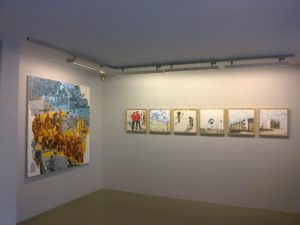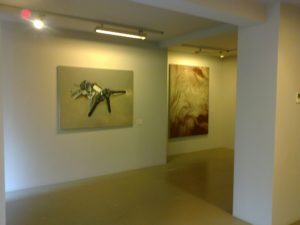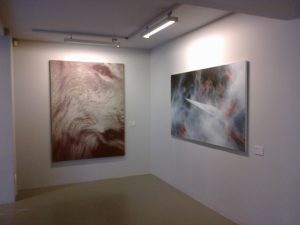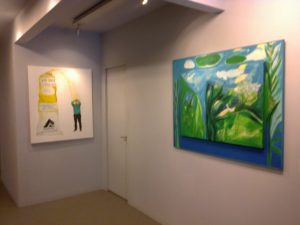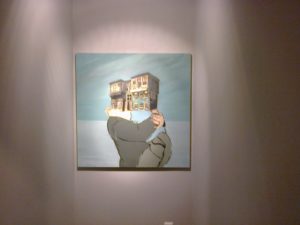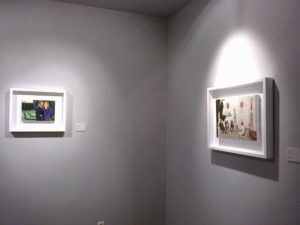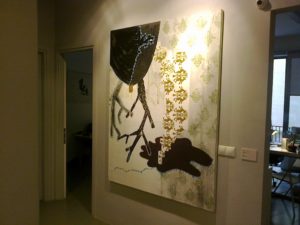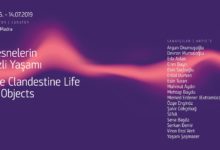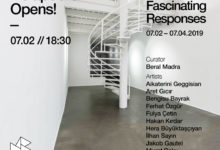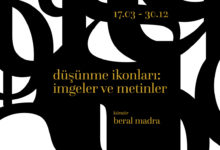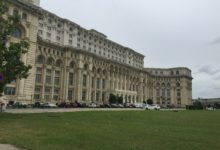IMAGES OF THE SENSIBLE / DUYUMLANABİLİRLİĞİN İMGELERİ
Artists/ Sanatçılar
TANER CEYLAN, TİMUR ÇELİK, FULYA ÇETİN, LEVON FLJYAN (ARMENIA), KHALED HAFEZ (EGYPT), RAZİYE KUBAT, ALİ İBRAHİM ÖCAL, FERHAT ÖZGÜR, MUSTAFA PANCAR, ALJONA SHAPOVALOVA (RUSSIA), MELTEM SIRTIKARA, OLGU ÜLKENCİLER, NALAN YIRTMAÇ.
Curator/Küratör
Beral Madra
11.03.2014 – 19.04. 2014
Concept Text
After the record sales of Francis Bacon’s triptych in November 2013, painting may have multiplied its already established economic power in the global art market. However in the global critical art debate, which is influential for the concepts, contents and aesthetics of contemporary art, the question “Is painting dead?” has been asked since 1850’s when the photography entered into the image production. The rise of video and installation art since the 1980’s has also opened a ground of competition for painting and the multi-cultural electronic images became the idols of the biennale. Yet another question is still effective why the majority of the artists and in particular young artists are choosing to paint, despite the various attractive techniques. Within this image making context to be a painter became a particular case and gave a different freedom to the painter who found a ground of productivity in working against this current. The public knowledge and consciousness correspondingly accepts the painting as an art historical medium since the drawings on cave walls and therefore appreciated as an artwork to be trusted. Another fact linked to this art-historical legitimacy is various familiar elements of representation in the paintings engaging the viewer in or giving him the possibility to identify himself/herself and his/her cultural legacy with. Painting is not marginalized and is not really under attack as indicated in many critical texts and statements but neither does it have the same religious, historical and art-historical primacy it once did. Painting doesn’t carry the political and religious representative influence and power as it once did and it cannot be as shocking as it once was when Cubism or Abstract Expressionism has transformed it into a very different representation. In consideration of 20th century art movements, and even today it is argued that everything has been done in painting, its content and form is exhausted. Evidently there are paintings rated as anachronism and decorative, repeating all the paintings that has been done before. A painting as decorative productions within the global and local markets is not our consideration. In the age of relational aesthetics paintings of an artist are considered to be significant, sustainable and subjective only because of their critical socio-political and philosophical content, particular techniques, drawing styles and color, which are inimitable and not duplicable. Painting in this sense is an individual and visual way of interpreting the world and the life as well as a life-long determination that conceptual accumulation, concentration and persistence. Painting as thus is an individual task, but at the same time a manifestation of every generation that creates its own imprint and leaves other issues for the next generation to solve. The paintings of the artists participating in this exhibition are visual implementations as all other techniques and implementations of interpreting the world and the life with subjectivity, knowledge, conceptual concentration and sustainable production. The paintings are intensely individual but also reflect the collective consciousness and manifestations of their time. In the age of relational aesthetics and aesthetic regime these paintings present a characteristic of a sensible way of existence. According to Rancière the distribution of the sensible is a political act and it is composed of the order, which formulates what is possible to see, hear, say, think, do and make involving perception, thought, and activity. All these are possible to capture by the senses. The title of the exhibition refers to this sensible, indicated by Jaques Rancière and expects the viewer to internalize these images of the sensible.
Beral Madra, January 2014
*****************************************************************************************
Konsept Metni
Francis Bacon’un ünlü triptiğinin Kasım 2013’deki rekor satışından sonra ekonomik gücü çoktan kanıtlanmış olan resmin küresel piyasadaki değeri bir kez daha yükselmiş olmalıdır. Çağdaş sanatın kavramları, içerikleri ve estetiği açısından etkin olan küresel eleştirel ortamda ise “Resim öldü mü?” sorusu 1850’lerde fotoğraf görsel temsiliyet, gösterge, gösterilen ve imge dünyasına girdiğinden bu yana soruluyor. 1980’lerde yerleştirmeler ve video sanat yükselmeye başladığında resim için yeni bir rekabet alanı daha açıldı ve bu tür yapıtlar bienallerde öne çıktı. Buna karşın resim yapan sanatçıların sayısı hiç bir zaman azalmıyor; dahası özellikle her kuşak sanatçının bütün diğer çekici tekniklere karşın son dönemde resim yapmayı yeğlemesi ve sürdürmesi de başka ilginç bir durum olarak beliriyor. Günümüzdeki çeşitli tekniklerde imge üretimi ortamında resim yapmak özel bir üretim ve bu çoğul seçenekler durumu resim yapan sanatçıya farklı bir özgürlük alanı sağlıyor. Sanatçı güncel imge akıntısının yönlendirmelerine karşı çalışırken kendisine adeta daha geniş bir üretim düzlemi buluyor. Toplum da resim konusundaki bilgisi ve bilinci bağlamında – ki bu mağara resminden bu yana var olduğunu bildiği resim olgusudur –resmi tarihsel derinliği dolayısıyla güvenilir bir sanat yapıtı olarak kabul ediyor. Bu sanat tarihsel meşruluğa bağlı olan başka bir gerçek de temsiliyetteki çeşitli bildik ögelerin izleyiciyi kendisine bağlaması ve ona kendisini bu kültür mirası ile kimliklendirme olanağı vermesidir. 20.yy boyunca yapılan keskin eleştiriler de resmin gücünü azaltmadı. Bir çok eleştirel metinde ve savda işaret edildiği gibi resim sanıldığı kadar saldırı altında da değildir. Yine de resmin geçmişteki tarihsel ve sanat tarihsel değer ve önceliğe, dinsel ve siyasal temsiliyet gücü ve etkisine sahip olmadığını kabul etmek gerekiyor. Resmi 20.yy başında tümüyle farklı bir temsiliyete dönüştüren Kübizm ya da Soyut Dışavurumculuğun yarattığı gibi köktenci değişim de söz konusu değil. 20.yy sanat akımları bağlamında ve dahası bugün de resimde her şeyin yapıldığı tartışılıyor; içerik ve biçim açısından tükenmiş olduğu ileri sürülüyor. Kuşkusuz yapılmış resimleri durmadan yineleyen, tarih dışı ve dekoratif olarak sınıflandırılan resim türleri var; ancak bu tür küresel dekoratif resim piyasasını besleyen resimler konumuz değil. Sergiye katılan sanatçıların resimleri diğer bütün teknikler ve araçlar gibi dünyayı ve yaşamı yorumlayan görsel bir araçtır ve öznellik içeren bilgi birikimi, düşünsel yoğunlaşma ve uzun soluklu çalışma içeriyor. Resimler bireysel bir üretim olmakla birlikte, üretildiği dönemin ortak bilincini de yansıtabiliyor; bir kuşağın ortak manifestosu olarak da değerlendirilebiliyor. Her kuşak ait olduğu dönemin sorunlarını irdeliyor, yorumluyor ve kendinen sonraki kuşağa çözülmesi ya da yorumlanması gereken başka konular ve sorunlar bırakıyor. Sanatçıların resimlerinde ısrarlı ve dirençli bir üretim ve emeğin özgün estetik, içerik ve biçim zenginliği izlenebiliyor. Resimler ilişkisel estetik çağında toplumsal-siyasal içerikler ve bağlantılar, öznel teknikler ve üsluplar ve sürdürülebilir üretim açısından önemli bir birikimden bir kesittir. Günümüzde Jaques Rancière’in sanat bilgisi ve eleştirisi bağlamında belirlediği sanatın estetik rejimi kavramı özel bir duyumlanabilirliğin varlığına işaret ediyor. Serginin başlığı da özellikle bu duyumlanabilirliği işaret ediyor. Sergi benzer duyumlanabilirliği izleyicinin de benimsemesini amaçlıyor.
Beral Madra, Ocak 2014

